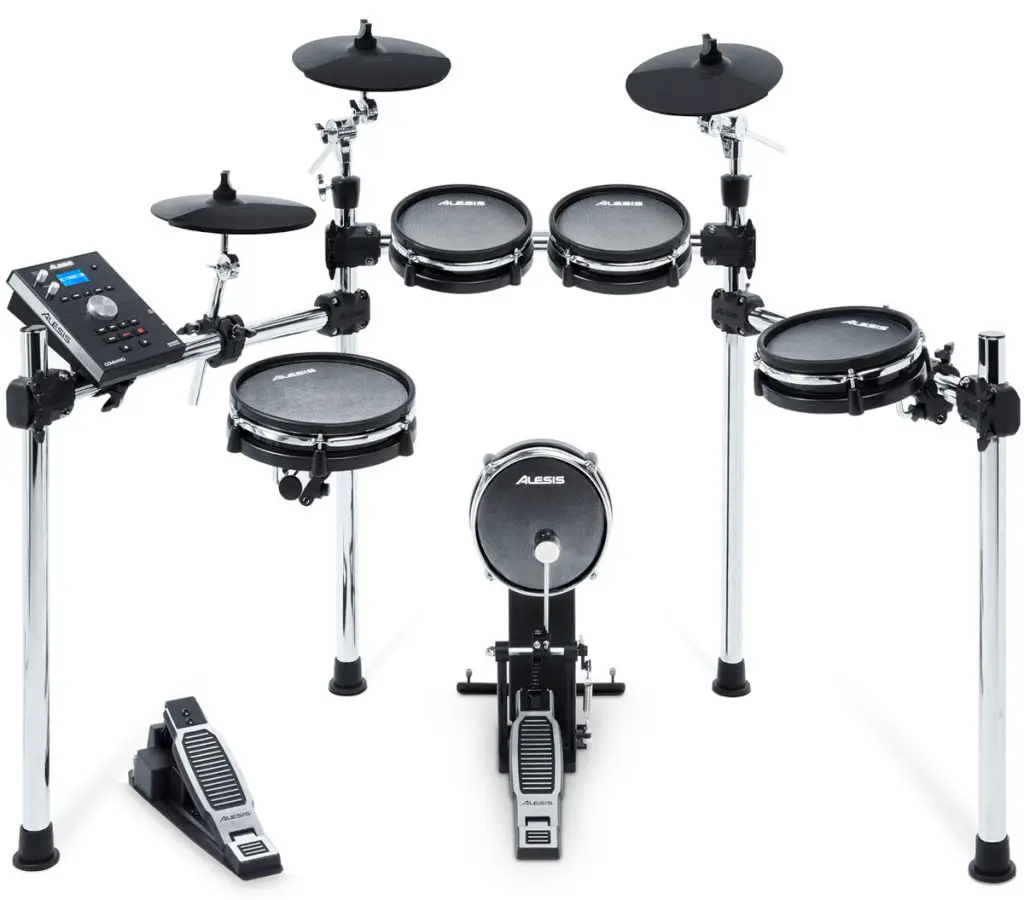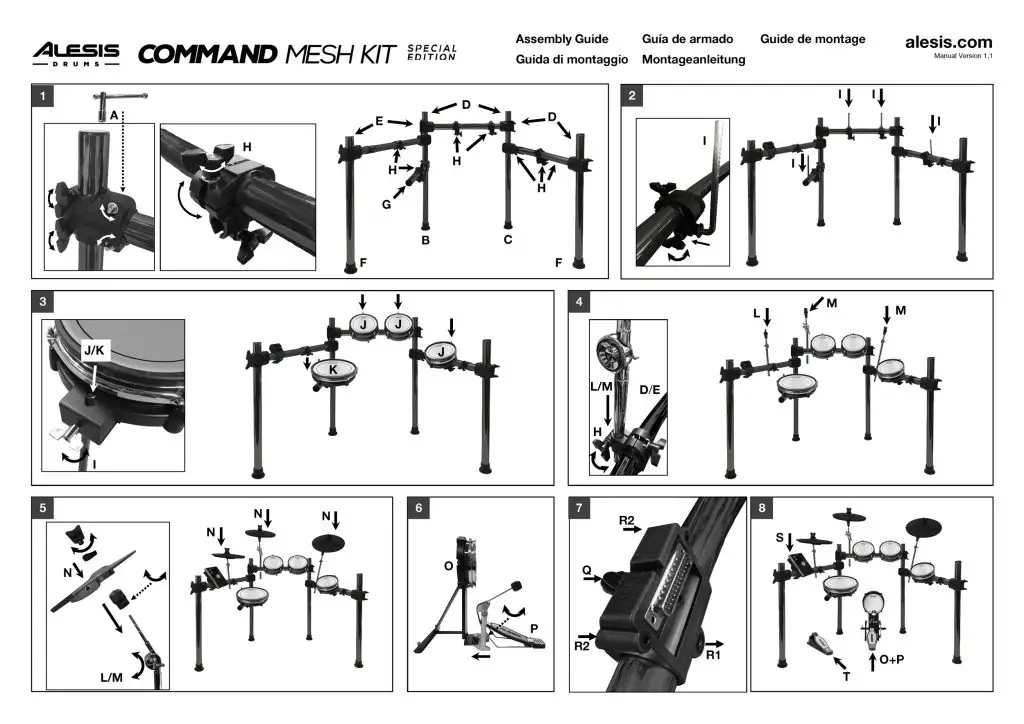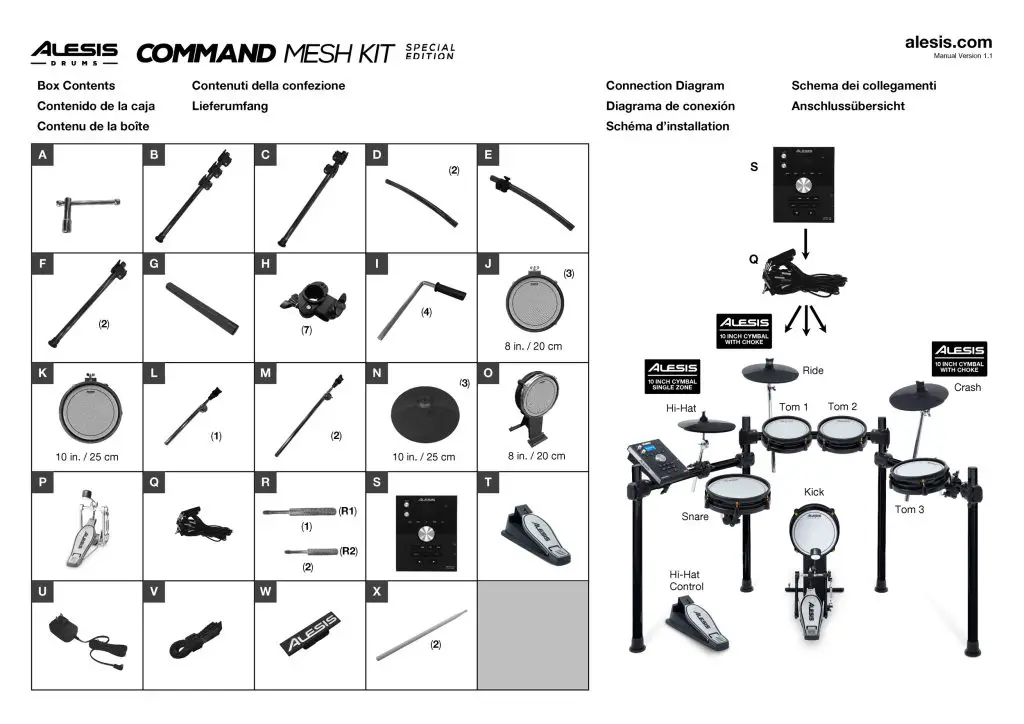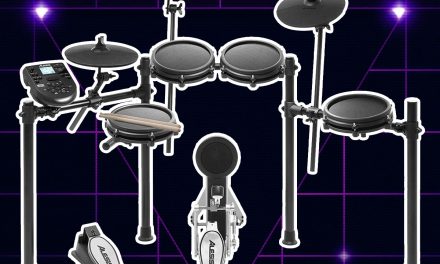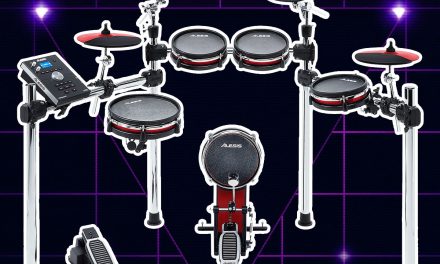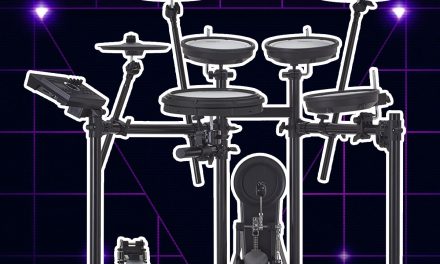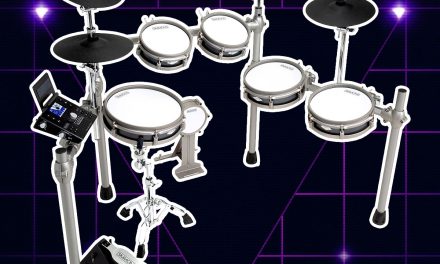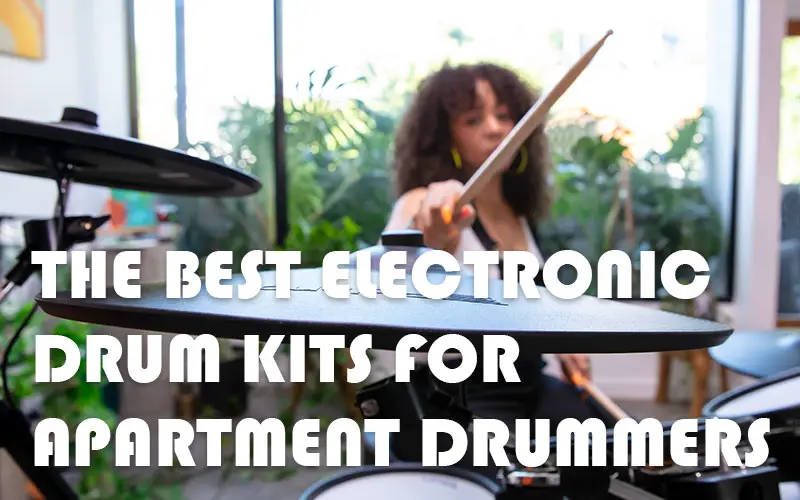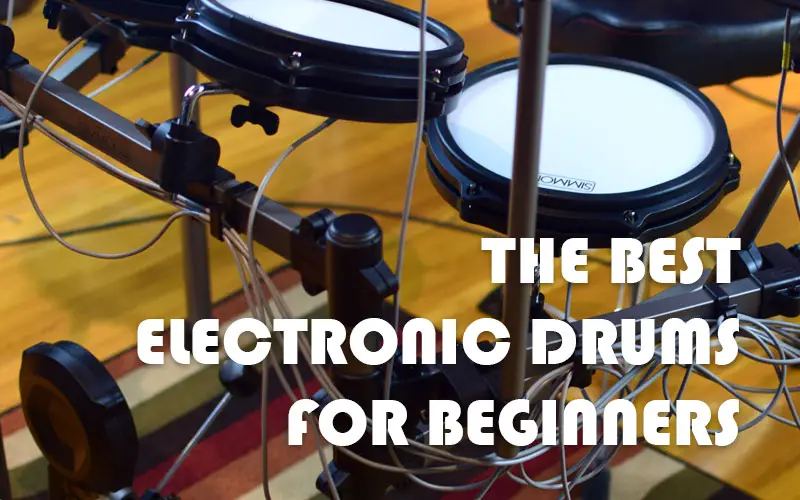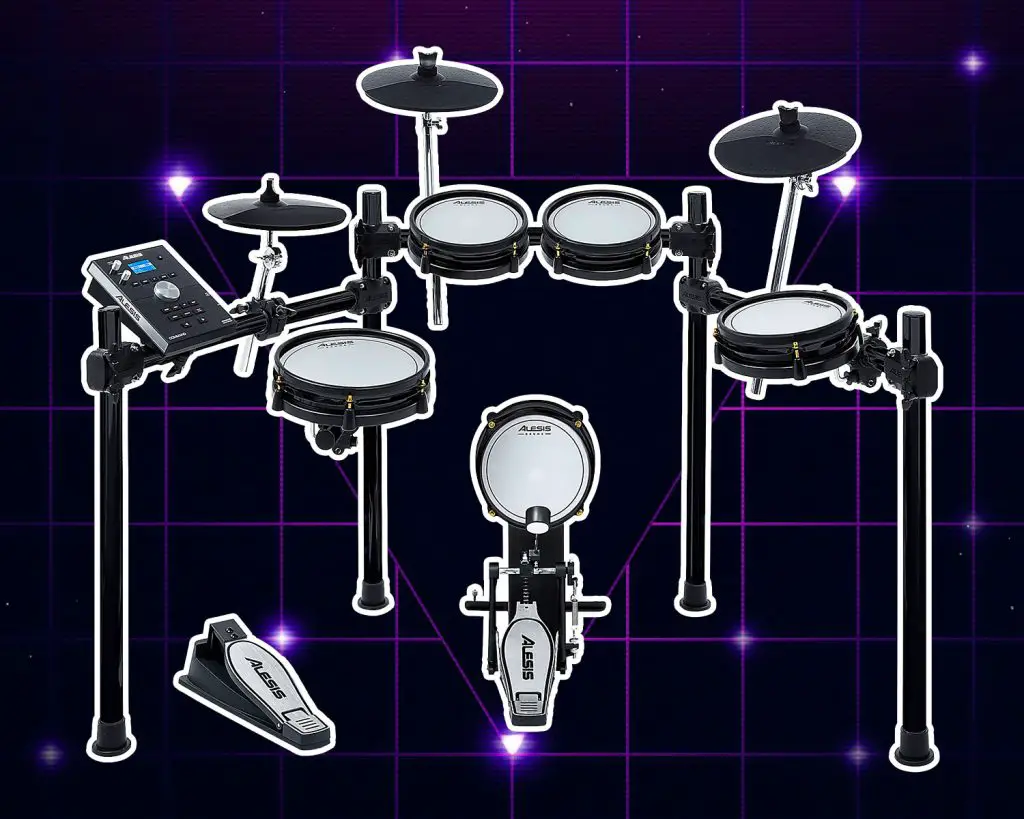
The Alesis Command Mesh SE electronic drum kit is the latest version of the Command Mesh lineup. It includes some changes from the last version, which we’ll go over shortly. There’s also the inclusion of a nice software add-on as well. This kit remains a fun option for a cheaper kit with mesh pads and a good sound module. Let’s take a closer look.
Amazon
What’s New for the Command Mesh Special Edition?
There are a few things that have changed from the previous version, mostly cosmetic.
- Alesis newer white 2-ply mesh drum heads are being used on this kit, as well as most of their other newer kits. They feel pretty similar to the black mesh heads from previous versions. They look better in our opinion.
- The black finish on the rack is another change, the previous version had a chrome rack. The black finish is very sleek and it goes well with the other color changes on the kit.
- The gold tension rod lugs around the kit are another cosmetic change.
- Alesis includes the BFD Player, which is a more basic version of the BFD drum software. The BFD Player gives you some high quality sampled studio drum kits that can be played by hooking the Command drum module up to a computer PC or Mac.
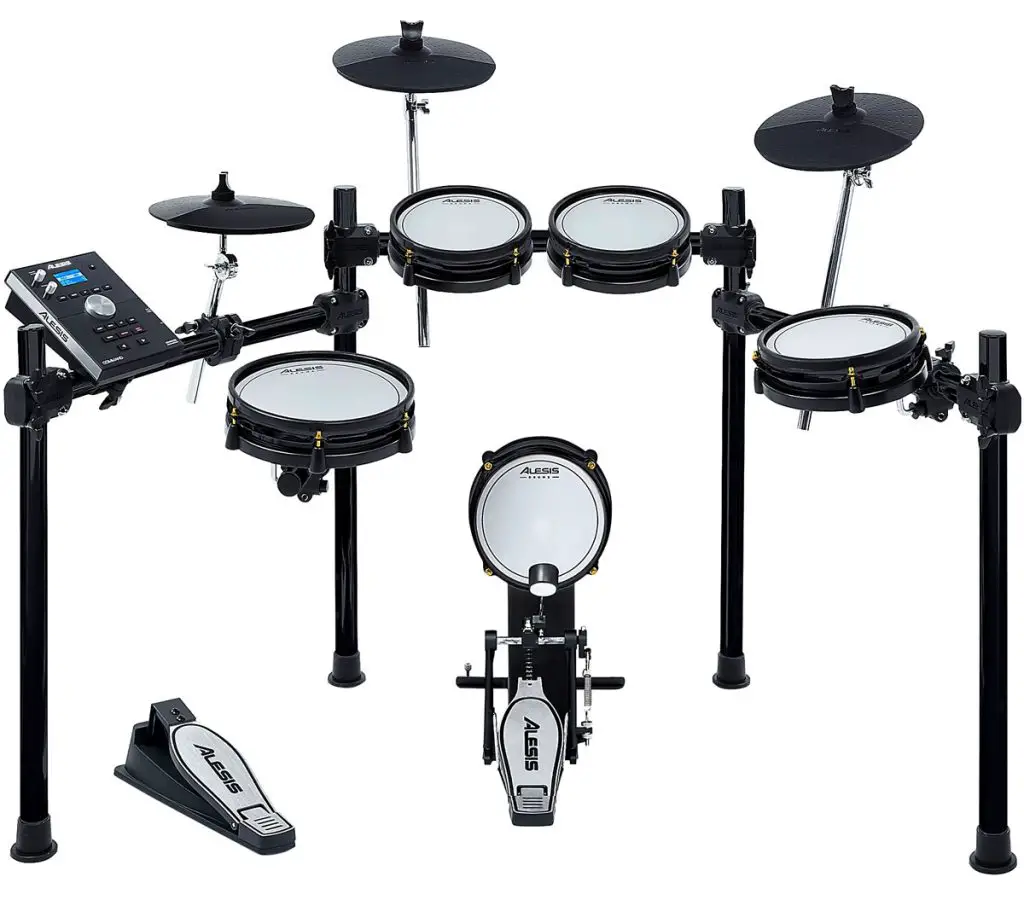
Command Mesh SE
Drum Pads & Cymbal Pads
This kit includes a nice lineup of dual zone mesh drum pads on the snare and toms. Unlike the cheaper Alesis kits, this is where you start to see better features on the pads all the way around the kit. The dual zone pads are great since they can generate different sounds from the rim, which can be very useful. For example, you can use the rim of the toms to play a cymbal sound, effectively adding more cymbals without adding more cymbal pads.
The included pads:
- 10 inch dual-zone mesh snare pad
- (3) 8 inch dual-zone mesh tom pads
- 8 inch mesh kick pad w/ stand
- 10 inch ride cymbal w/choke
- (2) 10 inch crash cymbal w/choke
- 10 inch hi-hat cymbal
Snare Pad
The snare pad is a 10 inch dual zone mesh pad. It has good response around the surface and there really aren’t any weak spots. The response is good and sticks bounce naturally. Tension can be adjusted so you can tighten it up more like a snappy snare head to get it closer to an acoustic snare feel.
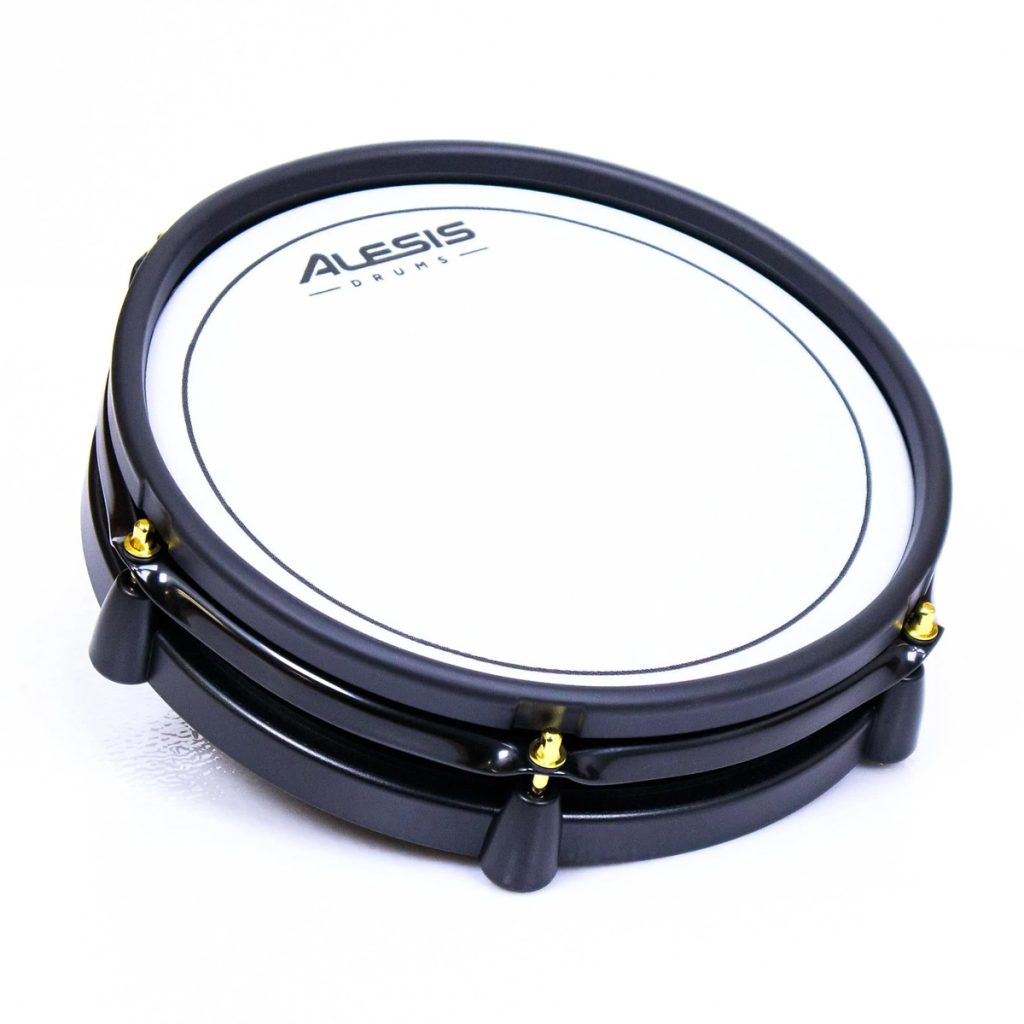
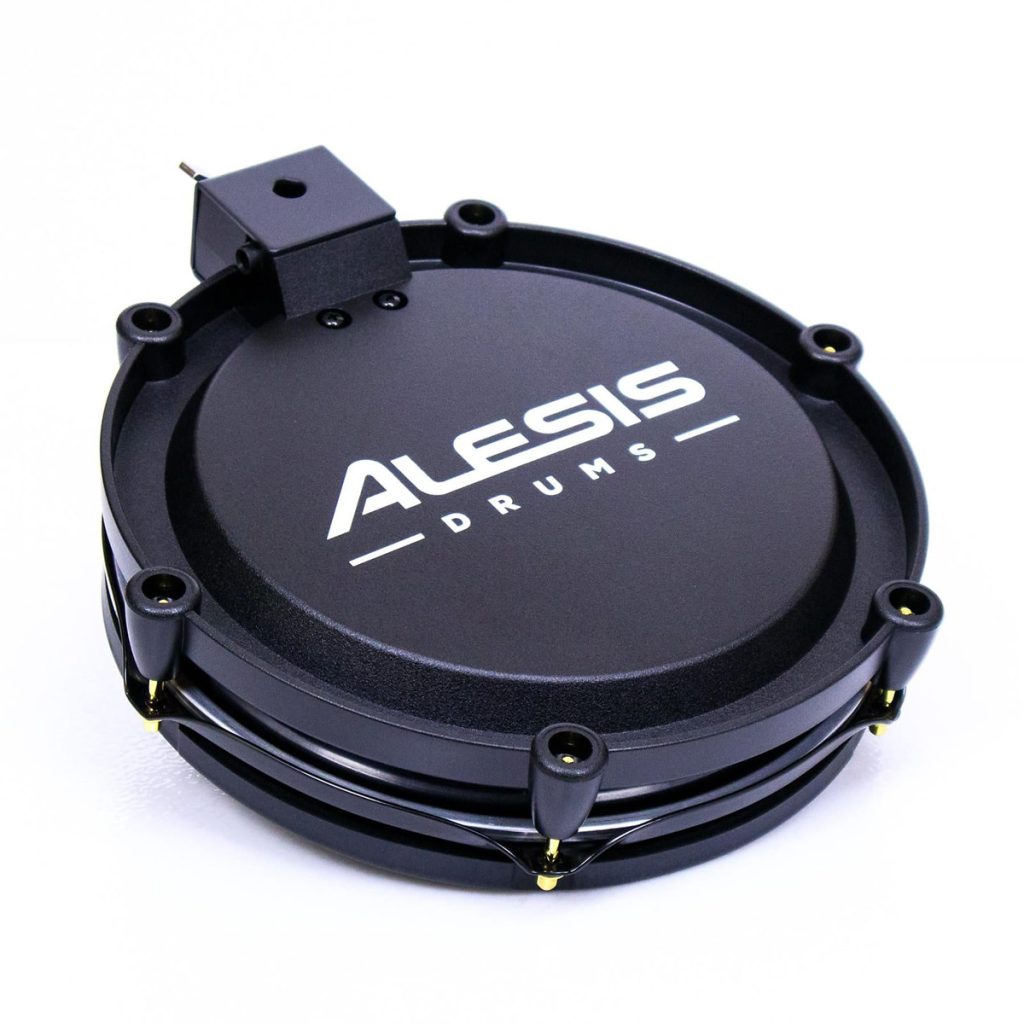
The tom pads are the same dual zone mesh heads as the snare, except for the 8 inch size instead. So they are a little smaller than the snare. The 8 inch target is starting to feel smaller, but they play nice. The the adjustable tension is nice on these pads too.
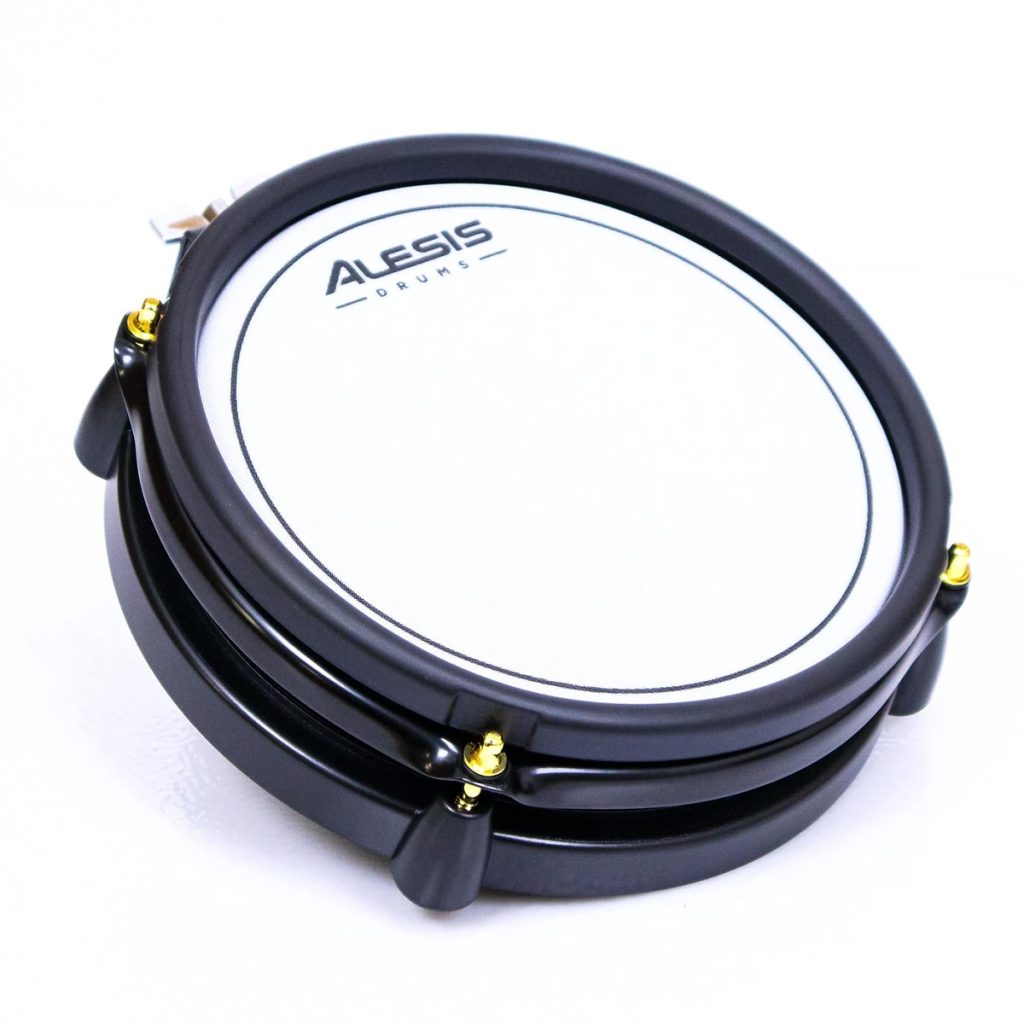
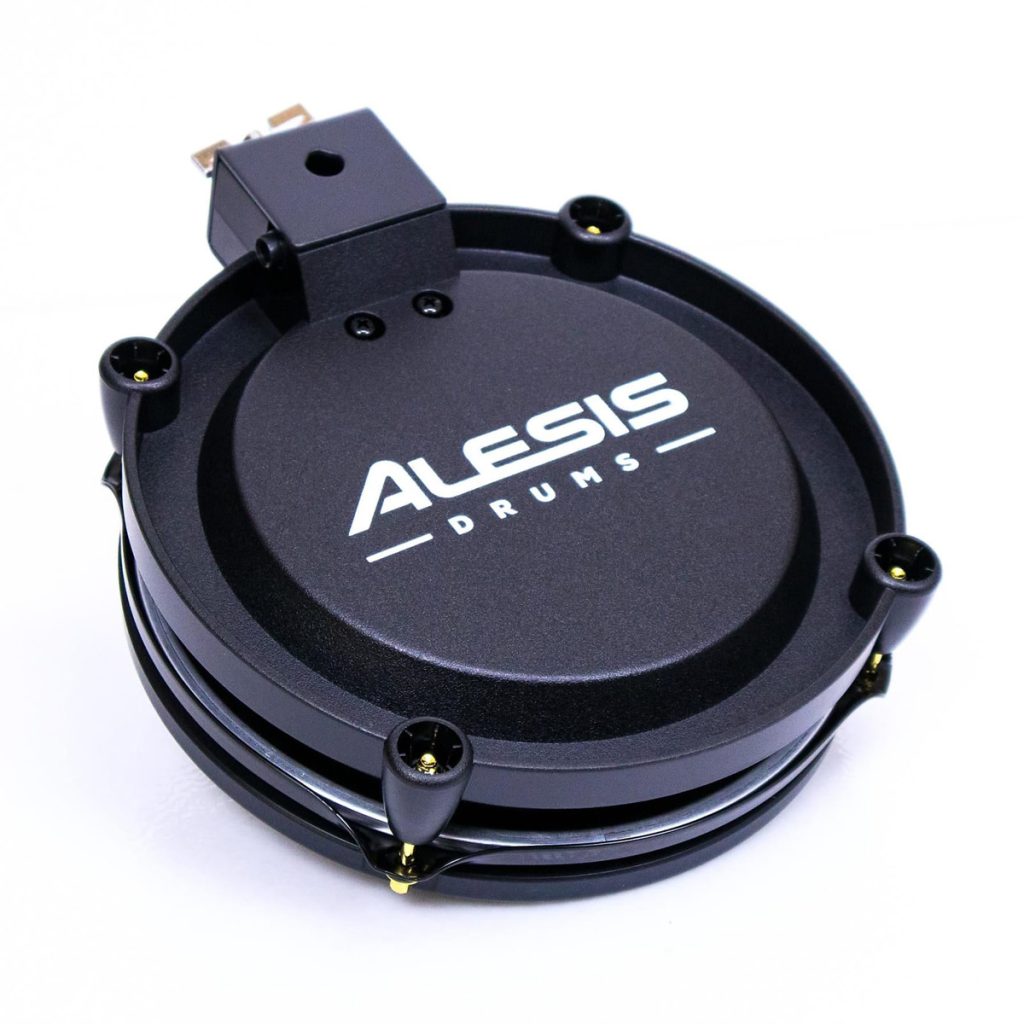
Cymbal Pads
The cymbal pads are one of the weaker points on this kit, but that doesn’t mean they are bad. They are mostly just lacking in features and they are smaller compared to the pad on more expensive kits. They are are all 10 inches in diameter.
The hi-hat pad is decent on this kit. It plays nicely in terms of physically sticking it and the rubber feel is about what you’d expect from an average rubber cymbal pad. The limitation on the hi-hat come in terms of sound generation. There’s really only 3 positions in the sound range, from closed to half open to open. It still sounds good but there’s not a lot of nuance in the positions.
There is 1 crash cymbal pad on the Command SE version and it is a single zone pads with a choke. They have a decent dynamic range when played but there’s not a lot of variation in the sound.
The ride cymbal pad feels like it is lacking since there is no bell zone. It is also a single zone pad with a choke. It’s basically the same as the crash pads.
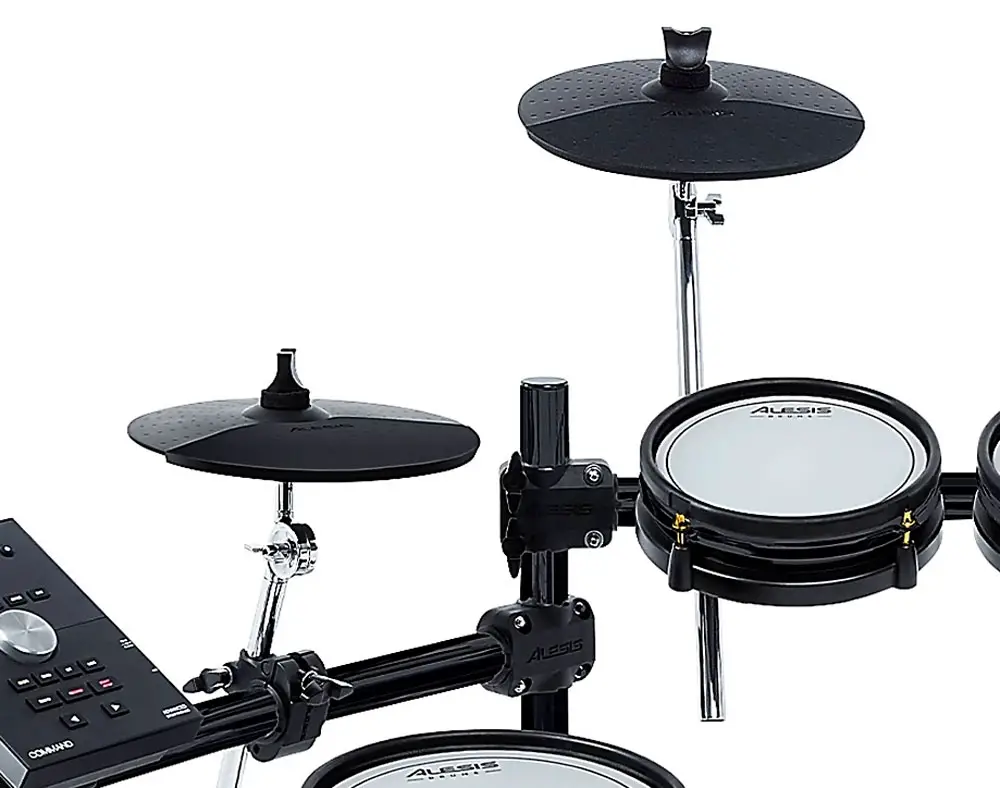
Feel & Playability
Drummers who play this kit like the feel of the drum pads. The mesh heads on the snare and toms are great and have a natural feel compared to harder types of drum pads. The strike zone on the pads isn’t narrow either, so you can hit around various areas on the pad heads and get a good sound response.
The cymbal pads are a little debatable. Most drummers find the cymbal pads to feel just fine when playing, they feel ok and much like a hard rubber drum pad.
Most of the complaints about the cymbal pads are about the lack of true dual zone sounds on the cymbals. They are billed as “dual zone” pads on this kit, but in this case that seems to mean that they have a hit zone and choke zone. There is no bell zone or edge zone on the ride, for example, and you have to hit it harder to generate the bell sound like on some other budget kits.
The kick pad has a little more of an acoustic feel with it’s mesh design and it works well in the context of an electronic kit. It still feels more like playing a practice pad than a real kick drum, but it’s certainly very playable.
In terms of noise, the drum pads are pretty quiet when hitting the mesh heads, and the cymbal pads have a sound like whacking on a practice pad. The kick pad has a little thump to it and it makes some noticeable noise.
The Rack
This drum kit includes a nicer rack than the cheaper Alesis counterparts. This is where you start to get into chrome rack territory. The rack is solid, sturdy and it also looks sharp. The non-slip clamps for the rack are plastic and similar to the clamps used on the cheaper Alesis kits. They hold the pieces in place well, and can be tightened up enough to make the kit feel like one solid piece.
This isn’t an overly huge rack, it’s still pretty compact, but it will give you enough room to add another pad or two if you want to expand the kit.
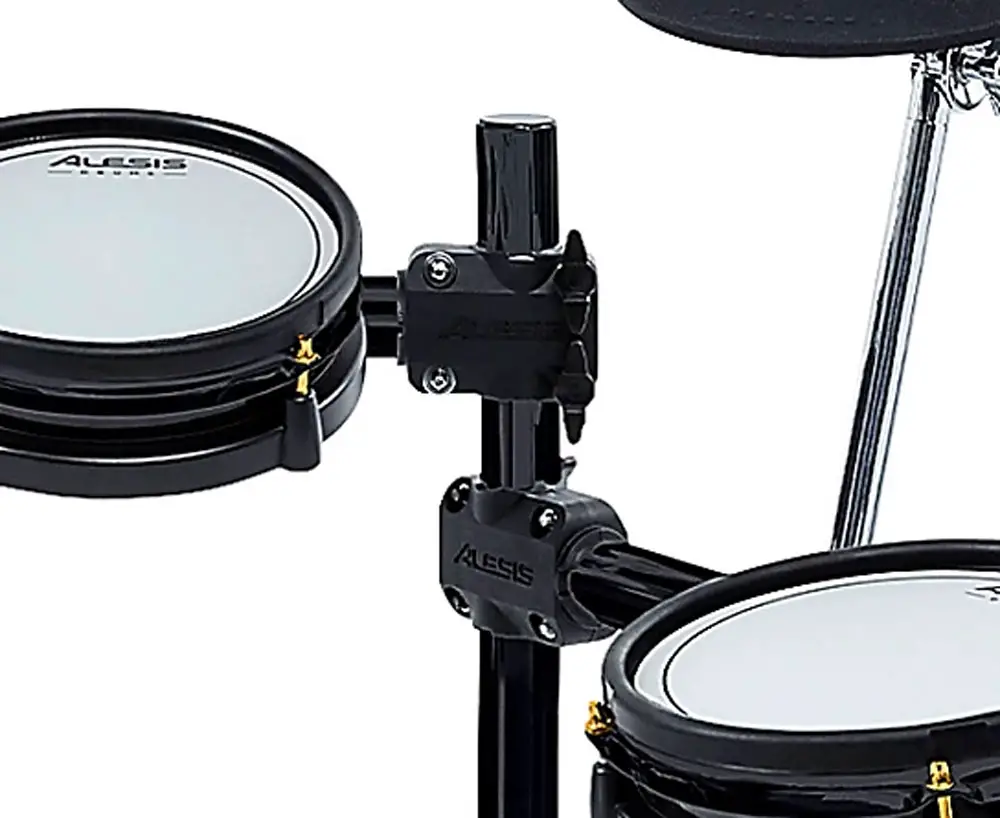
Sturdiness
For it’s smaller footprint and budget minded approach, this is pretty sturdy kit. Many drummers feel like they need to play more lightly on electronic kits, but harder players who play this kit say they don’t feel like they need to hold back at all.
The pads stay in place when the clamps are firmly tightened throughout the stand and nothing is going to move out of place while you play. The rack and pads might shake a little when you play them harder, but overall the kit has a solid, sturdy feel.
The Kick Drum Pad
The kick drum pad on this kit is a tower-style piece of hardware. It’s got some weight to it, and it sits solidly on the ground with big spikes to keep it in place on a rug or carpet. The kick pedal hooks up directly to it just the same as it would clamp onto a kick drum, so you can use any kick pedal with this kit.
The response is good and feels somewhere between a practice pad and and acoustic head. It’s a decent sized surface and response seems pretty good around the surface area, but it’s best to stay as centered as possible for the best trigger accuracy.
Also, make sure to use a beater with a smooth, hard beater surface to prevent wear on the mesh head. Using cloth beaters or textured beaters on mesh heads can wear them out faster.
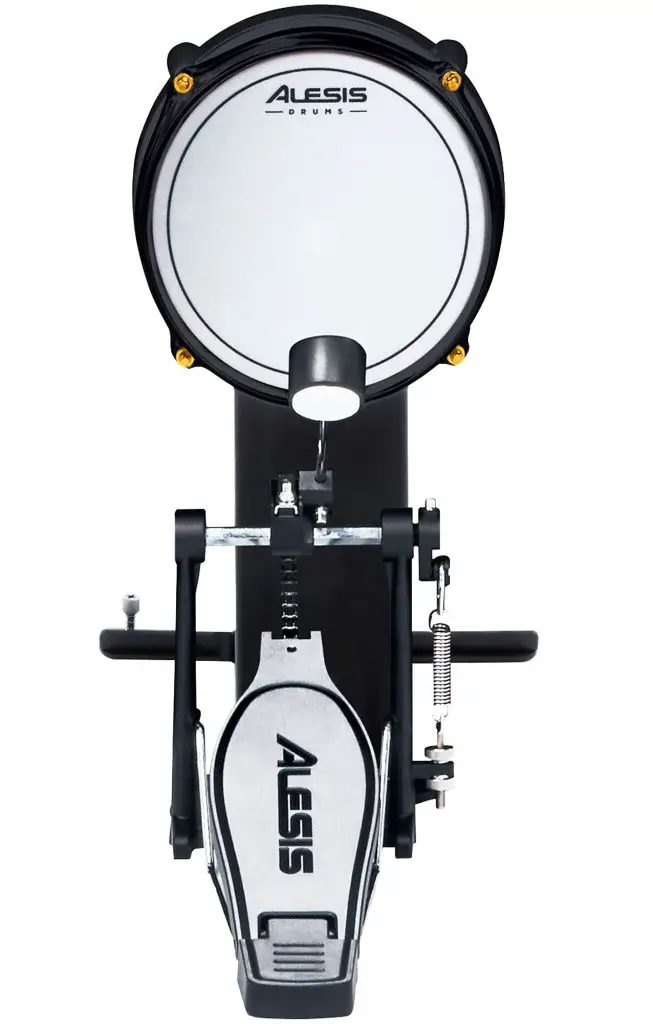
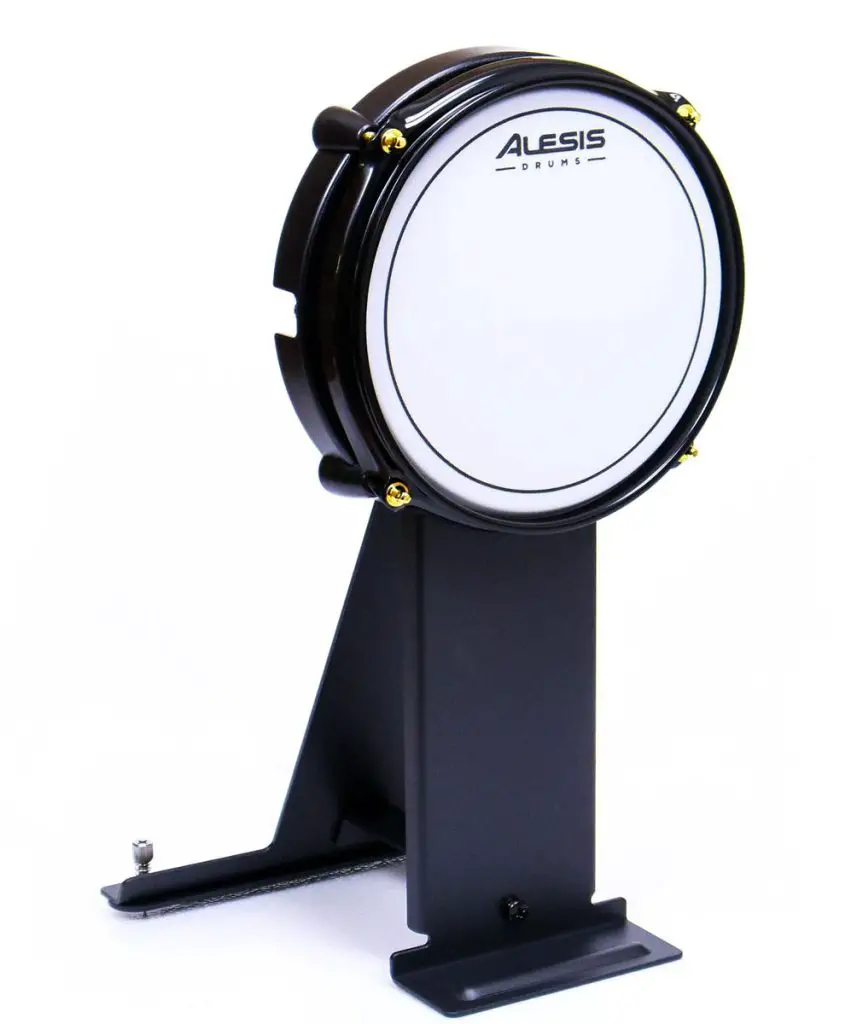
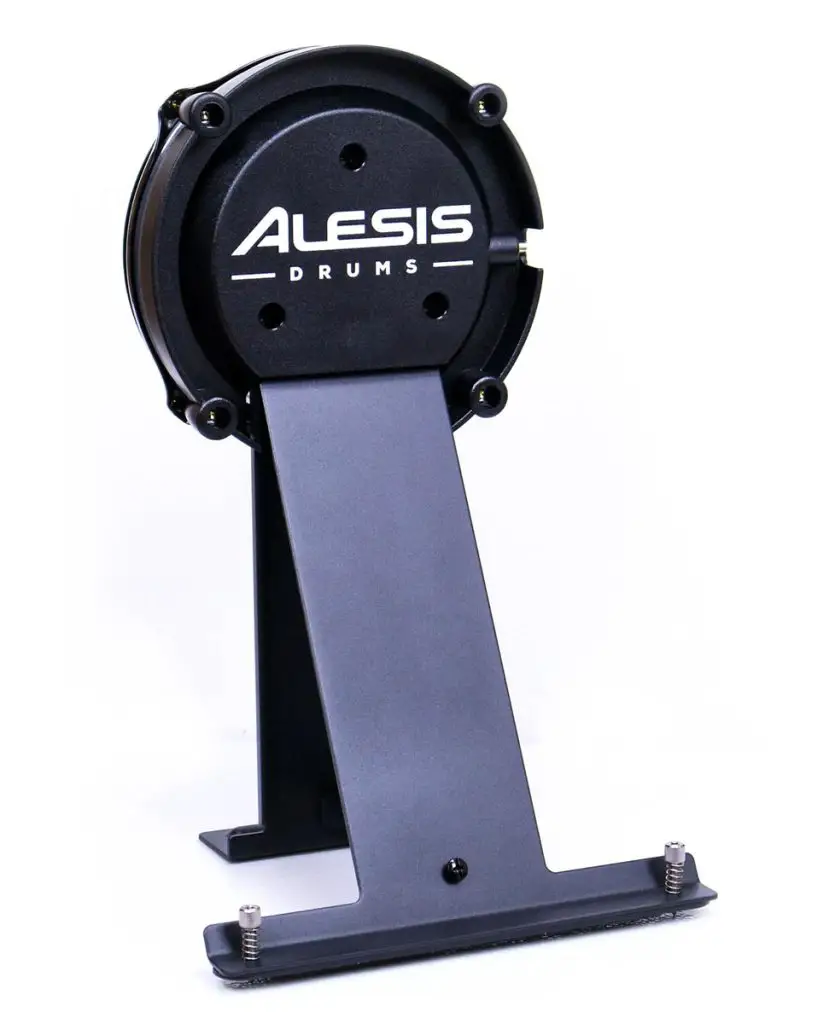
Double Kick Bass
The drum pad on this kit works great for double bass drum pedals. Drummers who want to play double kick haven’t had any issues using their pedals on this kick pad. I’ve used both Tama Iron Cobra and Axis Longboard double kick pedals on this type of Alesis kick pad and they both worked well.
Kick Pedal
This kit actually includes a kick pedal, which is a nice touch. If you don’t have any drum hardware yet and need a basic pedal to get started, this can be a very good value to have this included. However, if you don’t need the pedal, you might find the value of the kit to not quite be there since it’ll be hardware that you won’t use that contributed to the overall price.
It’s a decent chain drive pedal that they have included here. It’s nothing special, but not bad either. If you aren’t sure you want to invest in a better kick pedal, give this one a try first before you upgrade.
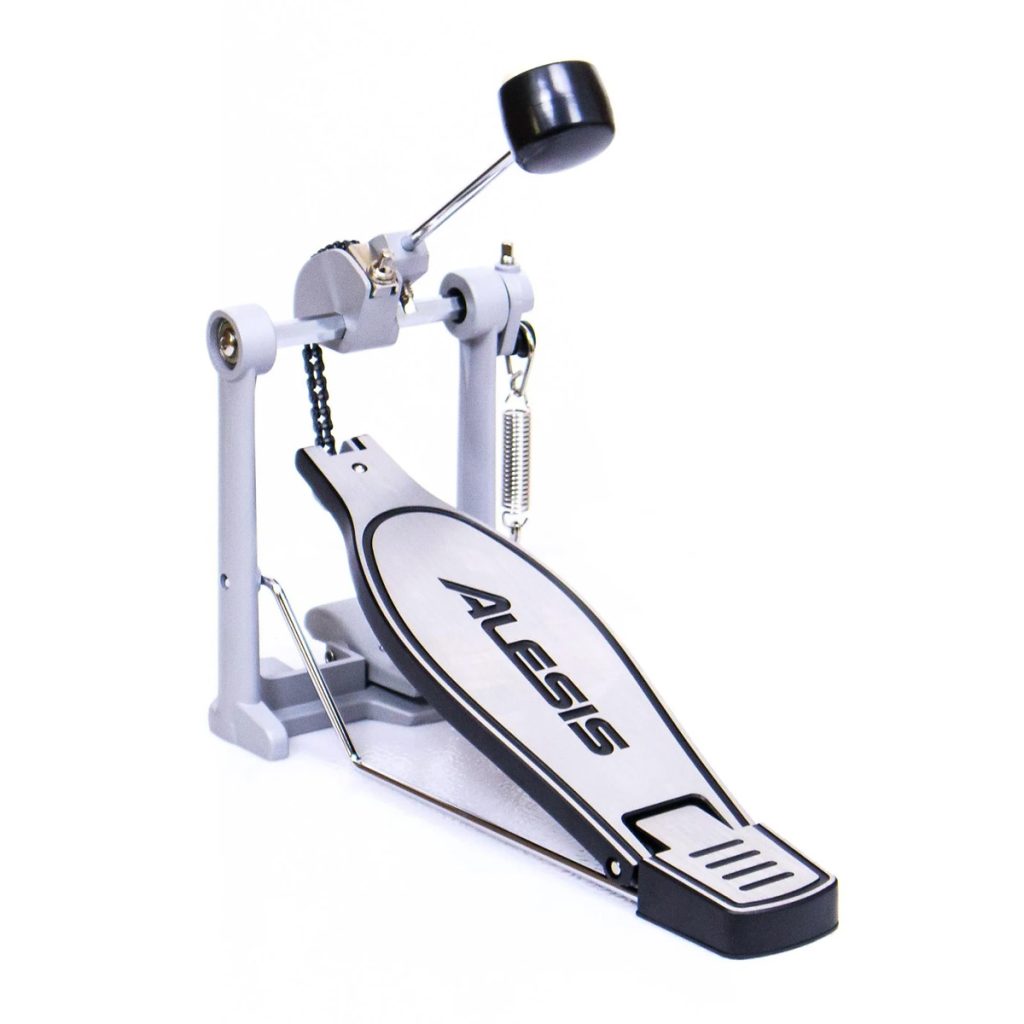
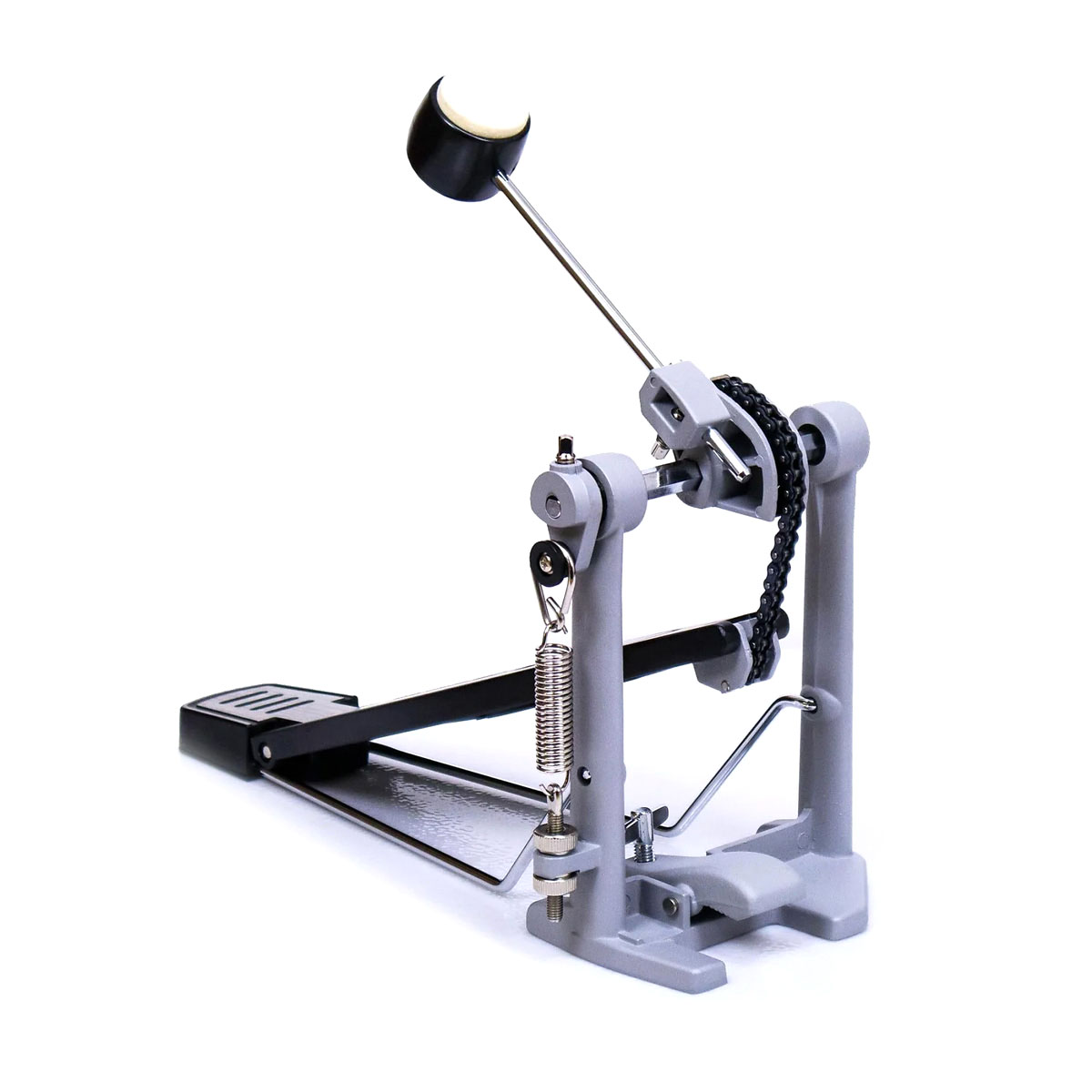
The Command Drum Module
The namesake drum module for this particular kit is the Command Drum Module. This is a more capable drum module than the cheaper Alesis kits will have. Let’s go over some of the features.
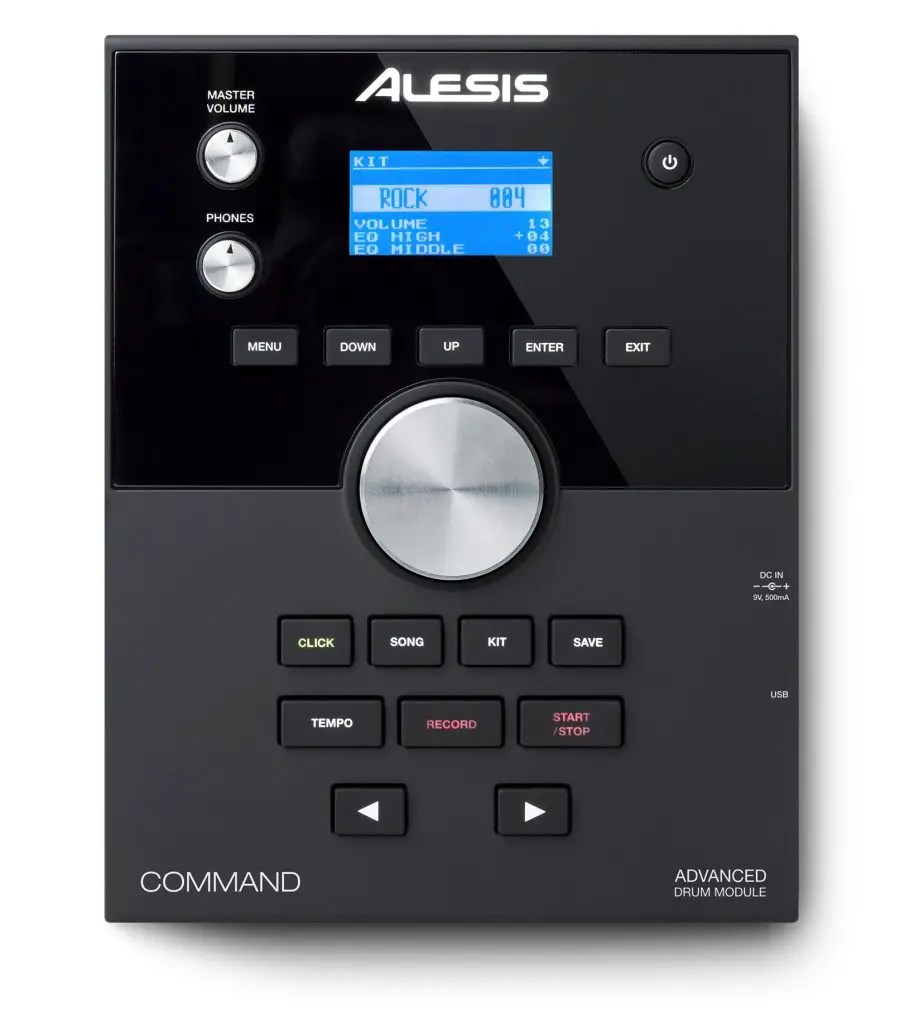
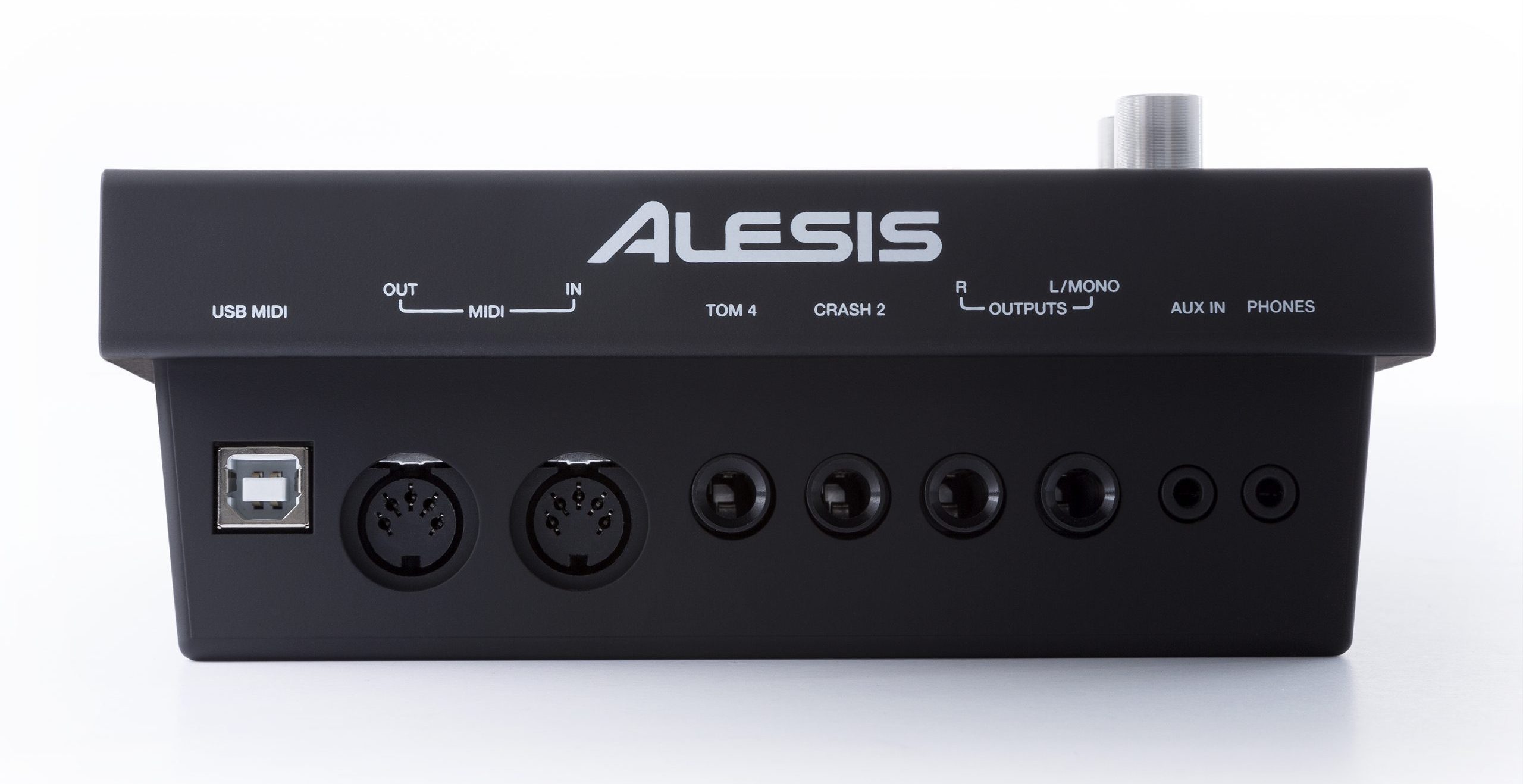
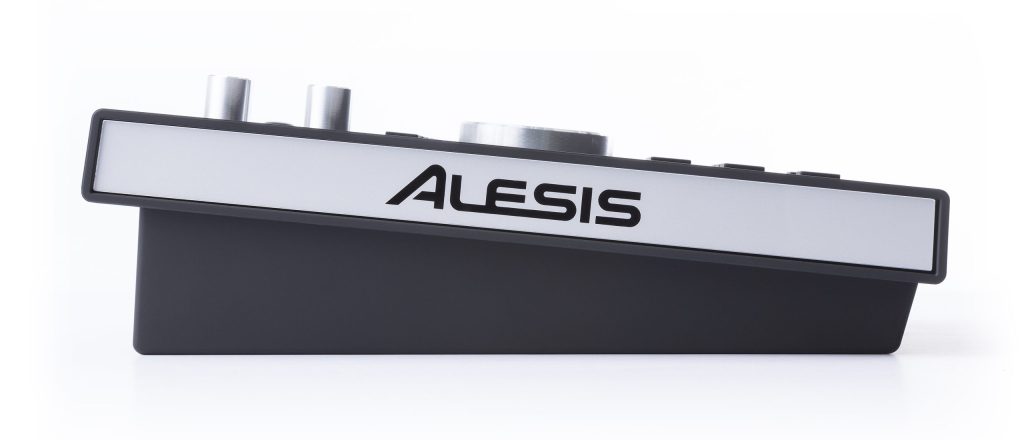
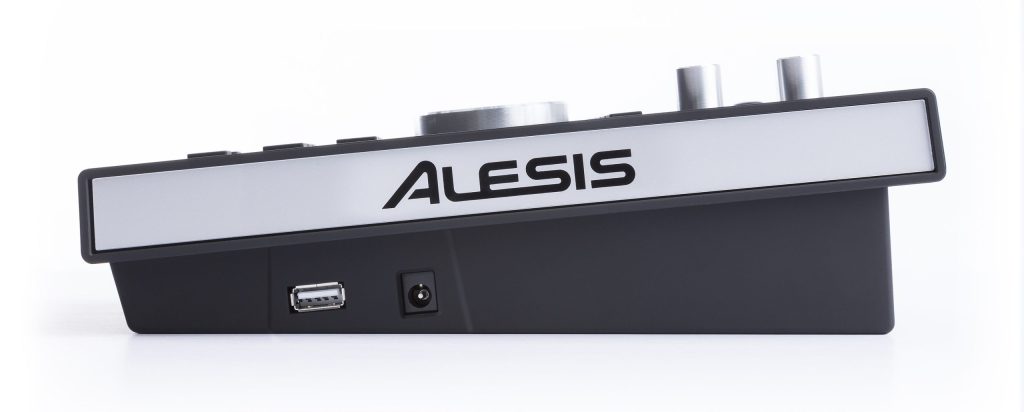
Interface
The interface is actually quite simple and straightforward, with a minimal amount of buttons. Things are named intuitively enough that you won’t need to do a whole lot of guessing if you don’t read the manual before trying it out. Many of the functions are accessed via navigating into menus in the screen display.
Inputs, Outputs and Connections
On the right side of the unit, you will find:
- The power input for the power supply
- The USB port where you can load sounds via a USB stick or drive
On the rear you will find:
- 3.5mm Stereo Headphone output
- 3.5mm Aux Input for connecting an audio player to play along with
- Stereo 1/4″ TRS outputs
- MIDI In/Out
- USB MIDI Port
- Additional 1/4″ crash trigger input for adding another cymbal pad to the kit
- Additional 1/4″ tom trigger input for adding another tom pad to the kit
The thing that jumps out to me about this module is the addition of the USB port to load sounds. That is something you won’t find on most of the cheaper kits out there. The expansion ports for additional pads are also nice to have if you want to grow your kit. Everything else is pretty standard.
Scope of Sounds
The Command module contains 54 preset drum kits and 20 user kit slots for saving your own drum kits. There are a total of 671 sounds according to Alesis. The kit/sound list published by Alesis shows 50 preset drum kits and 643 sounds in the reference list.
Overall, there is a nice mix of kit styles and sounds. There’s kits for all types of music that you might want to play. And the ability to load your own sounds or make your own kits adds just that much more flexibility out of the box.
The sounds themselves are pretty good. These aren’t top-tier electronic drum sounds by any means, but they don’t suck either. You may find the sounds to be very workable for your needs. If you are very discerning about your drum sounds you may find the built in sounds to be lacking. No problem though, you are able to connect the module to a computer or other sound modules via MIDI to completely open up your sound options.
Editing Kits and Voices
The module allows you to edit kits and voices to tweak the sounds to your liking. You are able to choose different voices (the sounds) for each slot in the drum kits.
You can also further edit the voices and pad settings to modify the sounds to your liking. You are able to adjust settings such as: Pan, Volume, Pitch, Reverb and Decay.
You are also able to change the mode of each pad for playback. What this means is that you can choose from among Polyphonic (sounds overlap as you play them), Monophonic (Sounds silence each other when a new sound is played) and other settings like stopping all sounds or activating the metronome.
Metronome
This module contains a metronome, as most modules do. Always practice with a metronome!
Play Along Tracks
If you are looking for basic tracks to play along with, the Command module includes 60 practice tracks. You can play along with them or even record your performances along with them to help with practice.
Trigger Settings
This module offers ability to change the trigger settings for the pads. This is where you are able to dial in the “feel” of your kit, and change how sensitive the pads are.
You are able to change the following for most pads, even though not all these options are not available for all of the pads:
- Sensitivity – How the pads react to stronger or lighter playing
- Rim Sensitivity – How the rims react to stronger or lighter playing
- Head-Rim Adj – Adjust the amount of cross talk between the head and rims – if you are hitting the rim and triggering the head, this setting can help tweak that issue, for example.
- Threshold – The amount of force in general that needs to be applied to generate a sound
- Xtalk – Cross talk settings allow you to control how much pads react to the vibrations coming from other pads being hit and triggered.
- Curve – Adjust the velocity curves to control how dynamic the sounds are in reaction to lighter or harder playing
- Retrig Cancel – Adjust the amount of time to produce two sounds. If you are getting a lot of double triggers from single hits, this setting can help with that.
Overall, the ability to tweak all these parameters will give you the ability to dial in specific settings to help the kit feel more natural to your play style. It’s well worth it to take the time to explore these settings after you initially get your kit setup, especially if you are a more serious drummer and will be playing the kit a lot.
Lefty Mode
One other nice thing about this module is that you can put it in “Lefty” mode, which reverses the input of the pads on the modules, allow you to set thing up in reverse and still play it.
USB Drive and Loading Sounds
A standout feature for this module in it’s price range is the ability to load sounds from USB and save kits to USB drives.
The ability to load sounds is probably the most interesting to most people reading this. You can load individual samples to replace voices in the user kits. There are some limitations, as outlined in the manual:
- Each sample must be a 16-bit mono WAV file with a maximum size of 15 MB. It can have a sampling rate of 48, 44.1, 32, 22.05, or 11.025 kHz.
- The sounds can’t be deleted individually from kits after they are loaded, you only have the option to delete all samples from a kit at once.
In addition to loading sounds, you can save kits to USB if you run out of user slots on the module.
MIDI Settings
MIDI works as expected on this module, and doesn’t do anything really crazy that you can’t find on other budget modules. This module allows you to choose between either playing the sounds on the module or outputting to MIDI and deactivating the sounds on the module. You are able to change the MIDI notes for each pad, which gives pretty good flexibility in routing to external sound modules or devices.
Expandability
We touched a little bit on the expandability of this module. Here’s what you are able to do:
- Add another cymbal, with a dedicated input on the back for an additional cymbal pad
- Add another tom, with a dedicated input on the back for an additional dual zone tom pad
- Connect the module to external sound modules and devices via MIDI
Some drummers who use this kit have also found it easy to upgrade the hi-hat pads, the kick pads or other pads when needed.
BFD Player
Probably the best thing that’s been added in terms of adding more capabilities to this drum kit is the addition of BFD Player. The BFD Player is a stripped down version of the BFD drum software that is focused more on playing kits than the sound design options. You need to hook your Command drum module up to a computer via USB to use the software. This is a nice addition since the kits sound great and it can give you a preview of what a kit like this can do when hooked up to a computer.
It currently looks like the free version comes with just one kit, the Dark Mahogany kit. Expansion packs will cost extra. There’s been some people having issues with getting the BFD player working correctly on their PC’s, but many are having good luck so far. It’s early in it’s release so we’ll keep an eye out for more feedback.
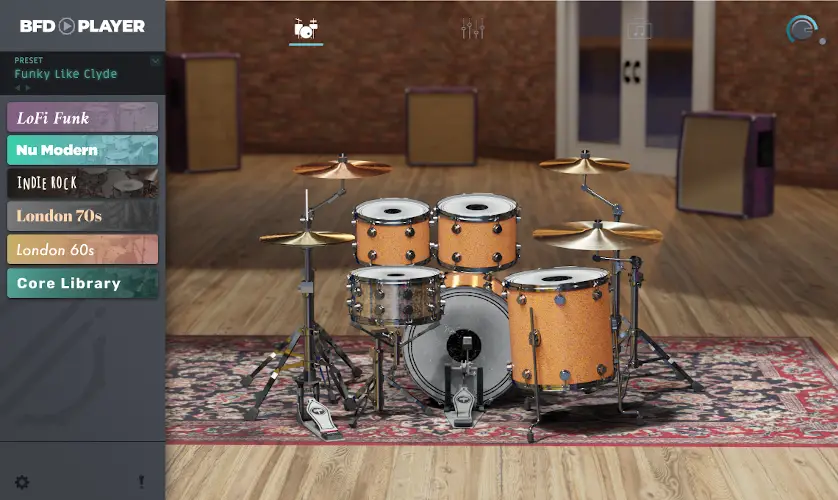
What’s Included?
When you purchase this kit, this stuff will be in the box and included:
- The Rack with clamps and mounting hardware
- Pads:
- Kick pad with stand
- 3 Tom Pads
- 1 Snare Pad
- Crash Cymbal Pad
- Ride Cymbal Pad
- Hi-hat Cymbal Pad
- Bass Drum Pedal
- Command Drum Module
- Cable Snake
- Power Supply
- Cable Wraps
- Drum Key
- Drum Sticks
- BFD Player
- 30 day trial of Melodics
- User Guides and Assembly Guides
What’s Not Included?
What’s not included, but you probably will also want or need:
- Drum throne
- Headphones
- More drum sticks
- A different bass drum pedal
- A heavy, flat rug to keep the kit and pedals from slipping around
Setup and Assembly
Some people struggle to set up this kit easily, while others will find it easy. Most people who buy this kit seem to agree that the assembly instructions are lacking and can be a little confusing. Either way, you’re probably looking at about an hour or less to get this assembled.
A recommendation we have is to study the directions of the clamps and mounting bars very closely before putting them together, this will help prevent backtracking. It also can help to simply look at photos of the kit already assembled, in addition to the instructions, to help see how things are connected and aligned. Don’t rush assembly, take it slow and you’ll be fine.
When setting up the kit, don’t overly-tighten all the connectors and clamps right away. Only tighten things enough to hold them lightly in place at first, and then once you get the kit fully setup you’ll be able to adjust positioning of everything a lot more easily before finally tightening everything down harder.
Support
People who own this kit have run into varying levels of support response from Alesis. Some have found it easy to get parts replaced, while others have claimed support isn’t very helpful. Overall, as of recent, Alesis support seems to be pretty good and will help you out if you run into any issues. They are known for replacing parts as needed if parts fail or break.
Pros
- Slick sound module for this price level
- Ability to load sounds from USB
- Chrome rack is nice at this price level
- Kick pad big enough for double kick
- Dual zone pads on the snare and toms
Cons
- Cymbal pads feel like the weakest link on the kit
- Hi hat pedal can feel a little sloppy if you are used to a real hi-hat
- Included kick pedal might not impress many players
Overall Rating
3.5 out of 5.0 stars
Drum Module
3.0 out of 5.0 stars
Pads
3.5 out of 5.0 stars
Playability
3.5 out of 5.0 stars
Sturdiness
3.5 out of 5.0 stars
Expandability
3.0 out of 5.0 stars
Value
4.0 out of 5.0 stars
The Verdict
Overall, the Alesis Command Special Edition mesh kit is a good option for beginners who need a little extra hardware such as the kick pedal to get started. You’ll have a lot of fun with the Command sound module, it really does stand out when compared to the cheaper offerings from Alesis and other competitors in this price range.
It’s a very playable kit with limitations. The drum pads are great and the cymbal pads are a little lacking. If you want to get a solid electronic drum kit and don’t want to break the bank, this kit could be a good fit.
Amazon

